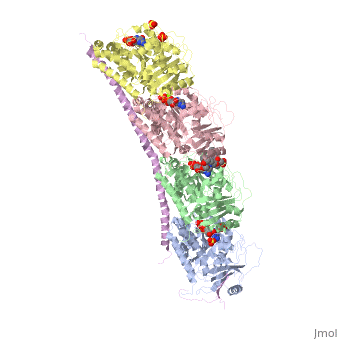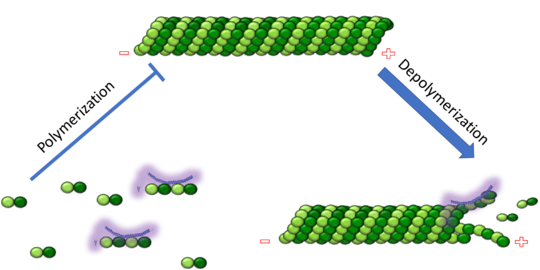User:Alisa Cario
From Proteopedia
(Difference between revisions)
| Line 29: | Line 29: | ||
<scene name='77/778894/Stathmin/1'>Stathmin</scene>, also known as oncoprotein 18 or metablastin, is a 19kDa microtubule associated protein known to destabilize microtubules <ref>PMID:8598048</ref>. Stathmin is a cell cycle and developmentally regulated protein, known to play a role in proliferation, differentiation, and function of cells <ref>PMID:9312271</ref> <ref>PMID: 9880330</ref>. Stathmin can bind to <scene name='77/778894/Highlight_of_tubulin/1'>tubulin dimers</scene> to inhibit polymerization or it can bind to the microtubule to enhance the rate of catastrophe<ref>PMID:8598048</ref> | <scene name='77/778894/Stathmin/1'>Stathmin</scene>, also known as oncoprotein 18 or metablastin, is a 19kDa microtubule associated protein known to destabilize microtubules <ref>PMID:8598048</ref>. Stathmin is a cell cycle and developmentally regulated protein, known to play a role in proliferation, differentiation, and function of cells <ref>PMID:9312271</ref> <ref>PMID: 9880330</ref>. Stathmin can bind to <scene name='77/778894/Highlight_of_tubulin/1'>tubulin dimers</scene> to inhibit polymerization or it can bind to the microtubule to enhance the rate of catastrophe<ref>PMID:8598048</ref> | ||
| - | '''Mitosis''': Stathmin's role in the cell cycle progression is well characterized. During interphase, microtubules are relatively stable. However during the onset of mitosis, stathmin is upregulated to increase the rate of catastrophe of microtubules, causing them to become more dynamic. Stathmin has also been shown to bind and sequester two tubulin heterodimers, reducing the amount of available tubulin to polymerize microtubules <ref>PMID:9312271</ref>. However, as mitosis progresses, microtubules must repolymerize to form the mitotic spindle. Stathmin is regulated during this process by phosphorylation <ref>PMID: 7982983</ref> <ref>PMID: 1737801</ref>. There are four known <scene name='77/778894/Stathmin_phospho/1'>phosphorylation sites of stathmin</scene>, serine 16, serine 25, serine 38, and serine 63 <ref>PMID: 8376365</ref>. Stathmin is the known target of cyclin-dependent kinases <ref>PMID: 9271428 </ref>. Stathmin overexpression prevents mitotic spindle formation where inhibition interferes with later stages in mitosis | + | '''Mitosis''': Stathmin's role in the cell cycle progression is well characterized. During interphase, microtubules are relatively stable. However during the onset of mitosis, stathmin is upregulated to increase the rate of catastrophe of microtubules, causing them to become more dynamic. Stathmin has also been shown to bind and sequester two tubulin heterodimers, reducing the amount of available tubulin to polymerize microtubules <ref>PMID:9312271</ref>. However, as mitosis progresses, microtubules must repolymerize to form the mitotic spindle. Stathmin is regulated during this process by phosphorylation <ref>PMID: 7982983</ref> <ref>PMID: 1737801</ref>. There are four known <scene name='77/778894/Stathmin_phospho/1'>phosphorylation sites of stathmin</scene>, serine 16, serine 25, serine 38, and serine 63 <ref>PMID: 8376365</ref>. Stathmin is the known target of cyclin-dependent kinases <ref>PMID: 9271428</ref>. Stathmin overexpression prevents mitotic spindle formation where inhibition interferes with later stages in mitosis <ref> </ref>. |
'''Migration''': The cytoskeleton is a vital part of cell migration. The leading edge is driven by actin polymerization ( ). However, microtubules are needed to retract from the trailing edge to move the cell forward. Stathmin is thought to have a role in migration, allowing to microtubules to depolymerize to aid in movement. Stathmin has been show to be a part of the integrin alpha5 beta1/FAK/ ERK pathway <ref>PMID: 9462839</ref>. | '''Migration''': The cytoskeleton is a vital part of cell migration. The leading edge is driven by actin polymerization ( ). However, microtubules are needed to retract from the trailing edge to move the cell forward. Stathmin is thought to have a role in migration, allowing to microtubules to depolymerize to aid in movement. Stathmin has been show to be a part of the integrin alpha5 beta1/FAK/ ERK pathway <ref>PMID: 9462839</ref>. | ||
| - | '''Differentiation''': Stathmin expression is regulated during stages of development. It is regulated in early and late embryogenesis | + | '''Differentiation''': Stathmin expression is regulated during stages of development. It is regulated in early and late embryogenesis <ref>PMID: 1893566</ref>. It is also regulated in differentiating muscle cells, T lymphocytes, and oligodendryocytes <ref>PMID: 22529300</ref> <ref>PMID: 14603467</ref>. |
== '''Structural Highlights''' == | == '''Structural Highlights''' == | ||
| Line 41: | Line 41: | ||
<scene name='77/778894/Stathmin_alone/1'>Stathmin</scene> consistis of a coiled coil alpha helix, that binds across two tubulin heterodimers, and a mostly disordered N-terminal region that also has some beta strand properties. These different regions of the protein are known to have different functions. | <scene name='77/778894/Stathmin_alone/1'>Stathmin</scene> consistis of a coiled coil alpha helix, that binds across two tubulin heterodimers, and a mostly disordered N-terminal region that also has some beta strand properties. These different regions of the protein are known to have different functions. | ||
| - | The <scene name='77/778894/Stathmin_nterm/1'>N-terminal region</scene> is known to increase tubulin catastrophe. This region helps destabilize the ends of the microtubule filaments by curving the tubulin dimers at the end, and disrupting lateral hydrogen bonds. The N-terminal region is known as the regulatory domain of the protein, because it is subject to most of the post-translational modifications. This region binds and caps alpha tubulin to accomplish this task | + | The <scene name='77/778894/Stathmin_nterm/1'>N-terminal region</scene> is known to increase tubulin catastrophe. This region helps destabilize the ends of the microtubule filaments by curving the tubulin dimers at the end, and disrupting lateral hydrogen bonds. The N-terminal region is known as the regulatory domain of the protein, because it is subject to most of the post-translational modifications. This region binds and caps alpha tubulin to accomplish this task <ref>PMID: 9880330</ref>. |
| - | The<scene name='77/778894/Stathmin_c_term/1'> C-terminal region</scene>, also known as the interaction domain, is known to sequester tubulin heterodimers. This region is comprised of a <scene name='77/778894/Stathmin_coiled_coil/1'>coiled-coil alpha helix</scene>. This region of stathmin is <scene name='77/778894/Zoom_of_stathmin_on_alpha/1'>known to bind to helix 10 of alpha tubulin</scene>. Helix 10 of alpha tubulin is thought to be important for incorporation into microtubules | + | The<scene name='77/778894/Stathmin_c_term/1'> C-terminal region</scene>, also known as the interaction domain, is known to sequester tubulin heterodimers. This region is comprised of a <scene name='77/778894/Stathmin_coiled_coil/1'>coiled-coil alpha helix</scene>. This region of stathmin is <scene name='77/778894/Zoom_of_stathmin_on_alpha/1'>known to bind to helix 10 of alpha tubulin</scene>. Helix 10 of alpha tubulin is thought to be important for incorporation into microtubules <ref>PMID: 9880330</ref>. |
The structure of stathmin, in 4eb6, is bound to two tubulin heterodimers. The tubulin dimers are bound to outside ligands. <scene name='77/778894/Vinblastine/1'>Vinblastine</scene> is a chemotherapeutic that binds to tubulin to prevent microtubule polymerization <ref>PMID: 1687171</ref>. The tubulin subunits are bound to from <scene name='77/778894/Gtp_gdp_highlight_of_tubulin/1'>GTP/GDP.</scene> The beta subunits of tubulin are bound to GDP and each of the alpha subunits are bound to GTP and a Magnesium ion. There are also <scene name='77/778894/Mutations_in_stathmin/1'>two mutations</scene> to the stathmin in this structure. The mutations at position 11 from an cysteine to an alanine and position 16 from a Phenylalanine to a Tryptophan. | The structure of stathmin, in 4eb6, is bound to two tubulin heterodimers. The tubulin dimers are bound to outside ligands. <scene name='77/778894/Vinblastine/1'>Vinblastine</scene> is a chemotherapeutic that binds to tubulin to prevent microtubule polymerization <ref>PMID: 1687171</ref>. The tubulin subunits are bound to from <scene name='77/778894/Gtp_gdp_highlight_of_tubulin/1'>GTP/GDP.</scene> The beta subunits of tubulin are bound to GDP and each of the alpha subunits are bound to GTP and a Magnesium ion. There are also <scene name='77/778894/Mutations_in_stathmin/1'>two mutations</scene> to the stathmin in this structure. The mutations at position 11 from an cysteine to an alanine and position 16 from a Phenylalanine to a Tryptophan. | ||
| Line 52: | Line 52: | ||
'''Multiple Schlerosis''': Stathmin expression is has been linked to multiple sclerosis (MS) , a neurodegenerative disorder characterized by lack of motor control and numbness. MS is caused by loss of myelination on axons in the nervous system. Myelination of axons is performed by cells called oligodendrocytes. Stathmin is regulated in oligodendrocyte lineage, with progenitor cells containing larger amounts than differentiated oligodendrocytes. Brain tissue samples from people suffering from multiple sclerosis found that stathmin is up regulated later in the lineage of oligodendrocytes. The up-regulation of stathmin showed a more globular morphology of the cells. Oligodendrocyte ability to myelinate axons in the central nervous system was greatly reduced in these patients <ref>PMID: 15659612</ref>. | '''Multiple Schlerosis''': Stathmin expression is has been linked to multiple sclerosis (MS) , a neurodegenerative disorder characterized by lack of motor control and numbness. MS is caused by loss of myelination on axons in the nervous system. Myelination of axons is performed by cells called oligodendrocytes. Stathmin is regulated in oligodendrocyte lineage, with progenitor cells containing larger amounts than differentiated oligodendrocytes. Brain tissue samples from people suffering from multiple sclerosis found that stathmin is up regulated later in the lineage of oligodendrocytes. The up-regulation of stathmin showed a more globular morphology of the cells. Oligodendrocyte ability to myelinate axons in the central nervous system was greatly reduced in these patients <ref>PMID: 15659612</ref>. | ||
| - | '''Cancer''': Due to stathmin's role in mitosis and cell migration, it is not surprising that is has been implicated in many cancers and is an active target of cancer therapeutics. Stathmin is defined as an oncoprotein. Overexpression of stathmin has been shown to increase metastasis, worse prognosis, and increased chemoresistance | + | '''Cancer''': Due to stathmin's role in mitosis and cell migration, it is not surprising that is has been implicated in many cancers and is an active target of cancer therapeutics. Stathmin is defined as an oncoprotein. Overexpression of stathmin has been shown to increase metastasis, worse prognosis, and increased chemoresistance <ref></ref>. Stathmin levels are known to be increasesd in a number of cancers. Stathmin was seen to be upregulated in breast cancer tissue comparative with normal breast tissue <ref>PMID: 10638981</ref>. Another study was done to show stathmin upregulation in esophageal squamous cell carcinomas <ref>PMID: 23229199></ref>. Studies using a non-phosphorylatable stathmin mutant shows that cells arrest during mitosis <ref>PMID: 9788875</ref>. |
| - | + | ||
| - | + | ||
Revision as of 23:20, 27 April 2018
* Full Real Name: Alisa Cario
- Position: Graduate Student
- Institution (NO ABBREVIATIONS): University of Vermont
- City, State/Province, Country: Burlington, VT USA
- Field of Expertise or Study: Creation of protopedia page for a class project. The class is Proteins 1 under Dr. Stephen Everse
Stathmin-4 (RB3) bound to Tubulin stabilized with Vinblastine
4eb6
| |||||||||||


